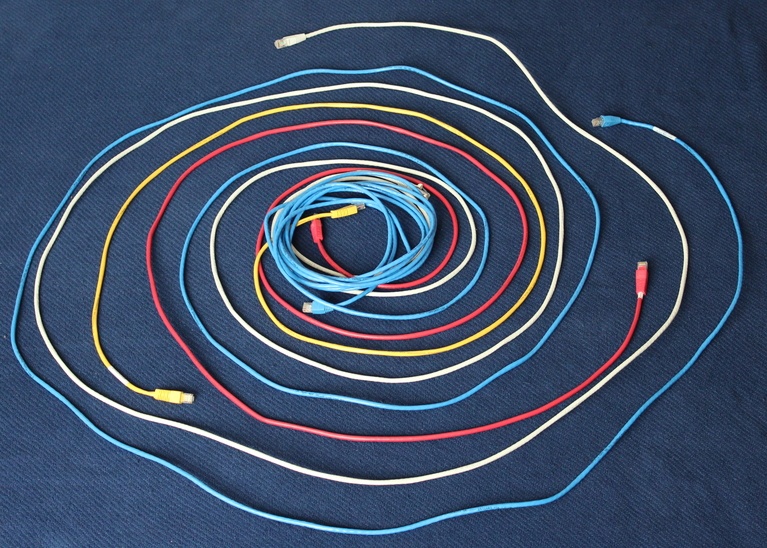
With Hurricane Irma dominating the news lately, I can’t help but notice the similarities between hurricanes and networks. While a meteorologist monitors a hurricane's changes in pressure via Millibars, an IT Manager measures network performance via Megabits Per Second (Mbps). But when either of these professionals sees a significant decrease in their respective metrics, it is cause for serious concern.
Obviously speed is the core metric used to measure how formidable any hurricane or network is. So it makes sense that hurricanes move into higher Categories when their wind speeds increase, just as your network cabling must be upgraded to a higher Category in order to achieve faster data speeds.
For example, a network infrastructure made up of Category 3 cabling will top out at a speed of 10 Mbps. If you upgrade to Category 5 (or 5e), then your data can flow at speeds of 100-1000 Mbps. And when you upgrade to Category 6, 6a, 7, and Cat8, your speeds increase exponentially. At least they should.
So why is it that after installing a Category 5e/6/7 structured cabling system in your facility, your network still may not be running as fast as it should be? This is a point of real frustration for conscientious IT Managers who have upgraded to the fastest network switches, installed high-speed copper and fiber optic cabling throughout their facilities, and implemented the most powerful, liquid-cooled servers on the planet -- only to hear network users continue to complain about slow speeds.
Like a chain, a network is only as strong as its weakest link...or as fast as its slowest component. So if your network still isn't achieving the speeds that the myriad hardware manufacturers promised in their marketing literature before you upgraded to their high-speed equipment, then your network cabling is likely the weak link.
The purpose of this three-part blog series is to highlight the three most common decision-making errors that IT Managers make when selecting and installing new network cabling, and how each will prevent your network from ever running at hurricane speeds.
Part 1 - CHEAP CABLING
In my 25 years in the networking industry, it has always baffled me when companies make a six- or seven-figure investment in a new, top-of-the-line, high-speed network with the best cabling and hardware money can buy, only to complete the solution with cheap patch cables they found online or at a local retail electronic store.
If your purchased a high-performance race car, would you shop online for cheap tires from some unknown off-shore company? Of course not. It's common sense that if you add even one cheap component to a high-quality solution, you are jeopardizing the potential performance of the entire solution.
So when you add cheap patch cables -- or even worse, cheap bulk cabling -- to your network in the hopes of saving a little money, you are probably increasing your total cost of ownership over the life of your network. Not only are cheap cables more prone to failure (meaning you will have to purchase replacements sooner than expected), but cheaper cables typically don't offer the extra headroom (bandwidth) of quality cables so their life-expectancy will be shorter than that of a higher-quality cabling infrastructure.
If you are wondering how two equally-rated cables can be so different, you need to understand how their performance is measured. In order for a Cat5e cable to be certified as a Category 5e connection, it must pass a number of specific tests while consistently meeting certain characteristics of performance across a bandwidth up to 100MHz. Certifying a twisted pair cable as a Category 5e cable guarantees compliance to the industry standards which represent the minimum acceptable performance requirements.
But some manufacturers have much higher quality standards than others. So while every certified Cat5e cable may meet the minimum performance criteria, it doesn't mean every Cat5e cable performs exactly the same. A number of premium brand cables continue passing Cat5e tests all the way up to 350 MHz.
Similarly, even though all certified Cat6 cables must operate within the defined performance characteristics at bandwidths up to 250 MHz, several premium manufacturers offer Cat6 cables that continue meeting the industry standards all the way up to 550 - 600 MHz. So what does this mean?
According to Andy Schmeltzer, Cable Technology Sales Engineer at Black Box Network Services, "While two different brands of cables may meet the Cat5e or Cat6 standard, one that is rated at 350 MHz or 550 MHz respectively will provide significantly more bandwidth and headroom than those that only meet the minimum baseline. Not only will the higher-rated cables support increasing bandwidth demands further into the future than a lower-rated cable, but they also tolerate sloppy installation and termination practices better."
So the next time you are considering the purchase of cheap cabling, make sure you recognize that it is an investment. Imagine that instead of a cable, you are purchasing something more significant...like a new car. If you must choose between buying a cheap car that will get you where you need to go but it’s both slow, very small, and won't last more than a couple years; OR a larger, faster car that costs a little more but will last twice as long, will get you where you need to go more quickly, and provides you with a lot more legroom/headroom to make your journey less cramped, which car would you choose? This same kind of decision process should be used when you choose network cabling.
Cabling is an investment in your future; one that will either provide you with a reliable solution that accommodates your current and future needs, or one with a much shorter lifespan that serves as a constant source of headaches until you replace it. Fortunately the choice is yours...choose wisely.
Obviously Cheap Cabling is a choice IT managers should avoid making when planning new networks. In our next two segments of this series, we will address the other two most common, cabling-related decision-making errors that result in network speeds being downgraded:
- Counterfeit Cabling - Posting on Tuesday, September 19th
- Improperly Terminated Cables - Posting on Wednesday, September 20th
Need help installing, troubleshooting, testing, documenting, or replacing your network cabling? Call Tech Service Today for on-site technical services anywhere in North America - often in 4-hours or less.
Just call (800) 973-2022 (option 1), or Email us at Service@TechServiceToday.com
